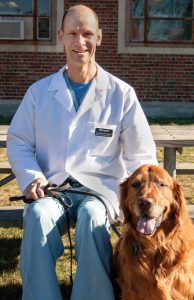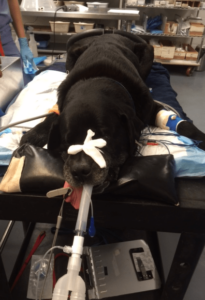-
Adopt
-
Veterinary Care
Services
Client Information
- What to Expect – Angell Boston
- Client Rights and Responsibilities
- Payments / Financial Assistance
- Pharmacy
- Client Policies
- Our Doctors
- Grief Support / Counseling
- Directions and Parking
- Helpful “How-to” Pet Care
Online Payments
Emergency: Boston
Emergency: Waltham
Poison Control Hotline
-
Programs & Resources
- Careers
-
Donate Now
 Kiko Bracker, DVM, DACVECC
Kiko Bracker, DVM, DACVECC
www.angell.org/emergency
emergency@angell.org
617-522-7282
Gastroesophageal reflux (GER) is when gastric contents passively pass from the stomach, up through the lower esophageal sphincter and into the esophagus. Gastroesophageal reflux occurs without any obvious outward signs and can happen in the awake, asleep or anesthetized patient. It also is a necessary precursor to regurgitation which is the outward manifestation of extreme reflux – that which reaches the oropharynx. Because an intraesophageal pH probe is needed to practically diagnose GER, this problem will go largely undiagnosed except in the research setting.
GER is a relatively common problem associated with canine anesthesia and it is identified in 17% to 50% of anesthetic events,1 depending on the study. GER usually occurs without any outward indication and puts the esophagus at risk of ulceration by exposing it to gastric acid. If the pH of the refluxed gastric contents is highly acidic (<4.0) which is common,2,3 the risk of mucosal damage is high, and worse yet if pepsin – a proteolytic enzyme secreted in the stomach – is present in the refluxed material. Of course, contact time of acidic contents in the esophagus also has influence on the amount of damage that occurs. One study4 found that lower esophageal pH was <4.0 for 16% of the procedure time (control group) while under anesthesia (normal esophageal pH is around 6.0)3. Certainly, mild peri-anesthetic GER may not prolong hospitalization or cause significant morbidity, but if severe5 it is possible for stricture formation to develop with resultant weight loss, aspiration pneumonia and even death.
 Many medications used during anesthesia are shown to reduce the tone of the lower esophageal sphincter including atropine, acepromazine, diazepam, morphine and other pure mu-agonists, halothane, isoflurane, xylazine and propofol.3,5,6 The timing of Cefazolin administration while under anesthesia did not seem to be linked to the timing of GER events.1,3
Many medications used during anesthesia are shown to reduce the tone of the lower esophageal sphincter including atropine, acepromazine, diazepam, morphine and other pure mu-agonists, halothane, isoflurane, xylazine and propofol.3,5,6 The timing of Cefazolin administration while under anesthesia did not seem to be linked to the timing of GER events.1,3
The type of procedure seems to have some influence on the development of GER. In a paper that looked at the incidence of regurgitation (not gastroesophageal reflux) in a larger population of anesthetized dogs (4,271 cases) they identified a 25 fold greater incidence of regurgitation in dogs that were having orthopedic procedures performed. It was suspected that this may be in part due to the higher frequency and dose of pure mu-agonists analgesics used in that patient population. Additionally, orthopedic patients were often repositioned multiple times under anesthesia prior to surgery and this manipulation may have triggered reflux events.6 In an earlier paper, though, intra-abdominal procedures resulted in more reflux events than other procedures.2 Interestingly, in the same study, patient position and even tilt of the surgical table had no influence of reflux frequency. No association was found between longer periods of pre-anesthetic fasting and lower rates of GER.1,3,6 Many dogs were fasted for >12 hours. In fact, it was suggested that longer fasting periods (18 hours) resulted in reduced gastroesophageal sphincter tone in awake dogs and may result in a greater frequency of GER.
Reglan (metoclopramide) is a commonly used medication to reduce the risk of reflux, regurgitation, and vomiting in the anesthetic period. When ‘standard’ doses of metoclopramide were looked at (0.4mg/kg bolus followed by a CRI of 0.3mg/kg/hr) there was no reduction in the rate of reflux compared to the control group. But when the dose of metoclopramide was increased (1.0mg/kg bolus followed by a CRI of 1.0mg/kg/hr) the relative risk of GER was reduced by 54%.3 Although no adverse effects were seen at this high dose, extrapyramidal signs (tremors, stiffness, jerky movements) are possible with high doses of this medication.
The most reasonable strategy that has been evaluated to prevent esophageal damage from GER is a combination of a proton pump inhibitor (esomeprazole) and cisapride, both given twice prior to anesthesia.4 This combination resulted in dramatically fewer reflux episodes (cisapride) and reduced the pH of the refluxant to neutrality (esomeprazole). Although oral cisapride and omeprazole (the most commonly used proton-pump inhibitor) were not specifically tested, it is likely that similar beneficial results would be seen with that combination. Interestingly, neither suctioning of the esophagus nor water lavage alone were shown to reduce the acidity of the esophagus post-reflux, but if the esophagus was lavaged with dilute sodium bicarbonate after suctioning and water lavage – the esophageal pH predictably rose to 7.0 for the duration of the procedure.8
Post-anesthesia regurgitation in our hospital generally manifests itself as frequent regurgitation for 1-3 days after a major anesthetic event. These episodes are usually managed with acid suppression, pro-motility medications, and/or esophageal mucosal barrier protection. Occasionally, more severe complications arise, but they are comparatively uncommon. We usually try to feed a patient small amounts despite the presence of regurgitation, unless feeding seems to worsen the problem. The most common acid suppressant use in our hospital is Protonix (pantoprazole) (1mg/kg IV BID) or omeprazole (1mg/kg PO BID). Mucosal barrier protection is achieved with a sucralfate slurry to coat the most distal esophagus where acid secretions can do the most damage. Promotility medications commonly used include metoclopramide (1-2mg/kg/day as a CRI, or 0.25-0.4mg/kg SQ/IV TID), ranitidine (1-2mg/kg IV BID) and occasionally cisapride (0.25-0.5mg/kg PO TID). Most dogs with this problem will steadily improve over a few days, but the above medications are usually continued for 7-10 days post-discharge.
For more information, please contact Dr. Bracker at emergency@angell.org or kbracker@angell.org, or call 617-522-7282.
REFERENCES
- DV Wilson, DT Boruta, AT Evans. Influence of halothane, isoflurane, and sevoflurane on gastroesophageal reflux during anesthesia in dogs. AJVR, 67(11), 2006: 1821-1825
- AD Galatos, D Raptopoulos. Gastro-oesophageal reflux during anesthesia in the dog: the effect of age, positioning and type of surgical procedure. Vet Record, 137, 1995: 513-516
- DV Wilson, AT Evans, WA Mauer. Influence of metoclopramide on gastroesophageal reflux in anesthetized dogs. AJVR, 67, 2006:26-31
- AC Zacuto, et al. The influence of esomeprazole and cisapride on gastroesophageal reflux during anesthesia in dogs. J Vet Intern Med, 26, 2012:518-525
- DV Wilson, R Walshaw. Postanesthetic esophageal dysfunction in 13 dogs. JAAHA, 40, 2004: 455-460
- C Lamata, et al. The risk of passive regurgitation during general anesthesia in a population of referred dogs in the UK. Vet Anaesth Analg, 39, 2012:266-274